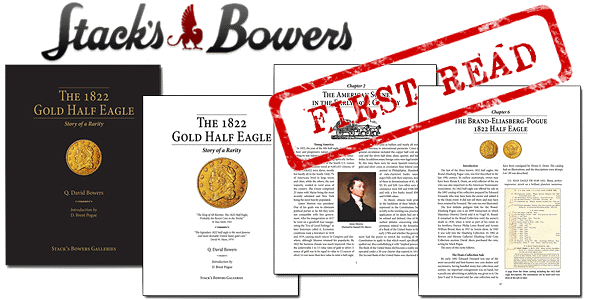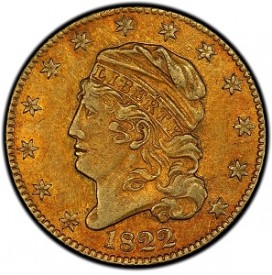
First Read, a continuing series of essays about classic and contemporary works of numismatic literature….
Review by Charles Morgan and Hubert Walker for CoinWeek….
First Read: The 1822 Gold Half Eagle: Story of a Rarity, and Treasures from the D. Brent Pogue Rare Coin Cabinet: A National Legacy by Q. David Bowers
Q. David Bowers and the Stack family have been involved in the promotion and sale of a great number of the 20th and 21st century’s finest numismatic collections and numismatic items of the highest import. It’s hard to imagine, but the forthcoming sale of the D. Brent Pogue Collection of early U.S. coinage may just be the capstone of their numismatic careers – and a key point in time for the industry, as Stack’s Bowers pushes back against the hegemonic power of Dallas-based Heritage Auctions.
Stack’s Bowers clearly understands the pressure they’re under to produce results. A partnership with New York luxury auction house Sotheby’s reminds us of Stack’s handling of the only legal-to-own 1933 double eagle, which it sold through Sotheby’s in 2002 for a record price of $7.6 million. That sale drew major national attention, partly due to the allure of the enigmatic ’33 double eagle but also due to the power of the Sotheby’s brand. Together, the two firms should provide the collection with a broad international audience made up of more than a few buyers from outside traditional numismatic circles.
In addition to that, Stack’s Bowers founder Q. David Bowers will write a series of books about different facets of the Pogue collection. These books will serve as historical documents about the sale and the coins themselves, as well as supplements to the forthcoming auction catalogs. Which, we can assume, will be of the highest caliber.
Bowers has made a career of supplementing great sales with numismatic literature. In fact, the cover art of one of the first two Bowers-Pogue treatments closely resembles Bowers’ The History of United States Coinage: As Illustrated by the Garrett Collection (Bowers & Merena Galleries, 1988). That book, a 572-page magnum opus, delves deep into the story of T. Harrison Garrett and Numismatics in the 19th and 20th centuries.
For his treatment of the Pogue Collection, Bowers lets the coins speak for themselves. And boy, do they.
The 1822

The 1822 half eagle gets full court press as the sole subject of Bowers’ first book. It’s as rare a U.S. coin as they come. Out of the reported mintage of 17,795, only three genuine specimens have ever materialized.
For more than a century and a half, one has served as the centerpiece of the United States Mint’s Mint Cabinet and one is in the Smithsonian Institution’s National Numismatic Collection. The second was gifted to the Smithsonian in 1967 by the estate of collector Josiah K. Lilly in exchange for tax relief from the United States Congress. At the time, the Lilly collection–including the 1822 half eagle–was valued at $5,534,808.
The Pogue Specimen traces its pedigree back to the 19th century numismatic sale of the collection of Hiram E. Deats. The cataloger, Edouard Frossard, offered no explanation as to the origins of the coin and Deats’ cabinet contained no other major rarities. For whatever reason, the lot wasn’t allowed to sell and later showed up in the collection of Mauritius David. From there, the list of owners is short and legendary: Brand, Eliasberg, Pogue.
A Monograph
Although the practice of writing monographs has more or less fallen by the wayside over the years, Bowers’ treatment of the 1822 reads like one.
Using the best available information, it describes the minting of the issue in detail and follows the chain of custody for the three known examples through the 19th and 20th centuries. It’s important to note that no 1822 half eagle has changed hands since the Eliasberg Sale in 1982.
Which is why, in our opinion, the 1822 is in many respects undervalued. Perhaps not in dollars–some estimate the coin will fetch more than $10 million, others we’ve spoken to suggest $7 or $8 million–but in the consciousness of the collecting public.
For this we have a theory. The 1822 is not a controversial coin. It wasn’t illegal to own for 70 years like the 1933 Saint. It was not, so far as anybody knows, restruck surreptitiously by employees of the U.S. Mint to capitalize on the small but very real coin collecting craze of the mid-19th century, like the novodel 1804 dollar.
Furthermore, there has never been an effort to “mainstream” the coin by publishing sensationalistic tales about it or overly hyping it up. It is, as it’s always been, a great rarity meant to be enjoyed by the select few.
It’s been 35 years since the last opportunity came up. It’ll take millions of dollars more to lock it away again.
***

The second “Pogue” book, Treasures from the D. Brent Pogue Rare Coin Cabinet: A National Legacy, offers a rundown of the “greatest hits” (ordered from 1 to 100) of the Pogue Collection as selected by Bowers and his staff.
The formula has been employed in a number of mass market numismatic books in recent years, most famously in the form of some of Whitman’s coffee-table picture books like 100 Greatest U.S. Modern Coins (2011).
The difference here, of course, is that what’s being presented isn’t general information about particular issues but specific information about particular coins–many of them the finest known.
That the Pogue Collection is so solid doesn’t need to be explained by us. By our estimate, the first 16 coins in the countdown should all surpass $1 million at auction. After that, you could make the case that each coin rounding out the top 100 would be the centerpiece of virtually any collection.
Target Audience
Bowers’ relationship with Whitman Publishing reveals a dichotomy in the type of works published for the collecting mainstream and the types of work published by the Stack’s Bowers imprint. Clearly, the former are reference books for generalists (or, on occasion, specialists for a particular series). The latter, like the fantastic U.S. Liberty Head $20 Double Eagles: The Gilded Age of Coinage (2014) and these two works, are written so as to promote forthcoming Stack’s Bowers auctions.
Because of this, it’s likely that the majority of readers are interested parties to the sale. In that respect, the books become tied to the sale as historic documents. Yes, there’s an underlying sales pitch involved with the purchase of the books. But asking coin collectors to consider a purchase of the finest coins American Numismatics has to offer is no hard sale.
For the rest of us, for whom appreciation and the satisfaction of knowledge will have to suffice, these books have value as well. They connect us to the unfolding of a great historical moment in the hobby.
One day, we’ll be able to tell our grandchildren that we got to see Michael Jordan play basketball. If they’re into coins too, then we’ll get to tell them that we witnessed the sale of the D. Brent Pogue Family coin collection as well.
****
The 1822 Gold Half Eagle: Story of a Rarity. 116 pp. Hardback, bound in black leatherette. Design recalls Bowers earlier work The History of United States Coinage: As Illustrated by the Garrett Collection.
Treasures from the D. Brent Pogue Rare Coin Cabinet: A National Legacy. 208 pp. Hardback, bound in black leatherette.




